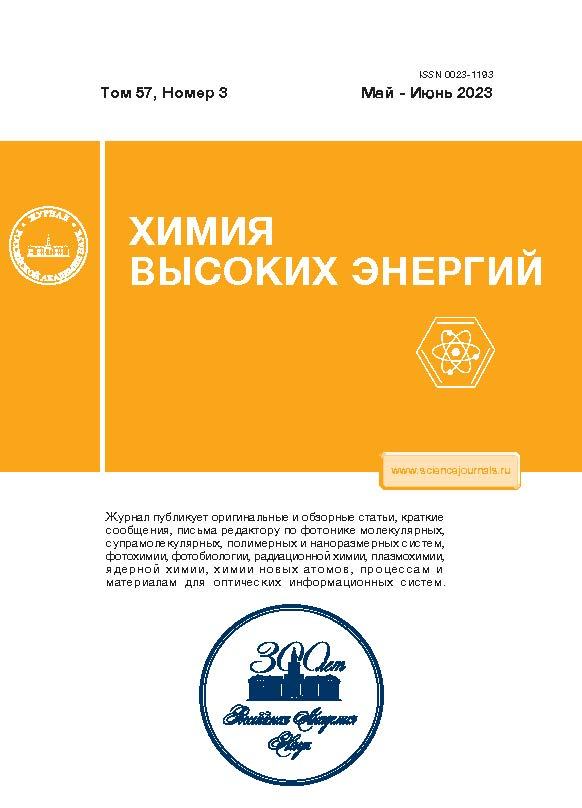Radiation-Initiated Dehalogenation of Organofluorine Compounds in Aqueous Solutions
- Authors: Tugai O.V.1, Kosobutskii V.S.1, Sverdlov R.L.1,2, Brinkevich S.D.1, Lastovskii S.B.3
-
Affiliations:
- Belarusian State University
- Research Institute for Physicochemical Problems, Belarusian State University
- Scientific and Practical Center for Materials Science, National Academy of Sciences of Belarus
- Issue: Vol 57, No 3 (2023)
- Pages: 206-210
- Section: RADIATION CHEMISTRY
- URL: https://rjraap.com/0023-1193/article/view/661506
- DOI: https://doi.org/10.31857/S0023119323030154
- EDN: https://elibrary.ru/KIASVD
- ID: 661506
Cite item
Abstract
The γ-radiolysis of 2-fluoroethanol-1, 2,2,2-trifluoroethanol-1, 3-fluoropropanol-1, and 4,4,4- trif luorobutanol-1 in aqueous solutions in an inert atmosphere or in the presence of oxygen has been studied. It has been found that the dehalogenation of hydroxyl-containing organic compounds is induced by •ОН and Н• radicals rather than hydrated electrons. The carbon-centered α-hydroxy-β-fluoroethyl radicals FCH2–•CHOH are def luorinated much more efficiently than α-fluoroalkyl radicals, both vicinal (F–•CHCH2OH) and nonvicinal (F–•CHCH2CH2OH). In the absence of oxygen, α-fluoroalkyl radicals
eliminate fluoride ions by the mechanism of nucleophilic substitution, and this process is enhanced in the presence of alkali. In an oxygenated medium, the dehalogenation of α-fluoroalkyl radicals occurs via the addition of oxygen molecules to them and the subsequent disproportionation of resulting peroxyl radicals. The dehalogenation of the α-hydroxy-β-fluoroethyl radicals FCH2–•CHOH is inhibited by oxygen through their oxidation.
About the authors
O. V. Tugai
Belarusian State University
Email: kasabutski@bsu.by
Minsk, 220030 Belarus
V. S. Kosobutskii
Belarusian State University
Email: kasabutski@bsu.by
Minsk, 220030 Belarus
R. L. Sverdlov
Belarusian State University; Research Institute for Physicochemical Problems, Belarusian State University
Email: kasabutski@bsu.by
Minsk, 220030 Belarus; Minsk, 220006 Belarus
S. D, Brinkevich
Belarusian State University
Email: kasabutski@bsu.by
Minsk, 220030 Belarus
S. B. Lastovskii
Scientific and Practical Center for Materials Science, National Academy of Sciences of Belarus
Author for correspondence.
Email: kasabutski@bsu.by
Minsk, 220072 Belarus
References
- Trojanowicz M., Bartosiewicz I., Bojanowska-Czajka A., Kulisa K., Szreder T., Bobrowski K., Nichiporc H., Garcia-Reyes J.F., Nałęcz-Jaweckie G., Męczyńska-Wiel-gosz S., Kisała J. // Chemical Engineering J. 2019. V. 357. P. 698.
- Бринкевич С.Д., Суконко О.Г., Чиж Г.В., Полойко Ю.Ф. // Медико-биологические проблемы жизнедеятельности. 2014. № 11. С. 151.
- Бринкевич С.Д., Тугай О.В., Невзоров Д.И. // Химия высоких энергий. 2019. Т. 53. № 4. С. 294.
- Лурье Ю.Ю. Аналитическая химия промышленных сточных вод / Ю.Ю Лурье. М.: Химия, 1984. 448 с.
- Бринкевич С.Д., Тугай О.В., Сладкова А.А., Шадыро О.И. // Химия высоких энергий. 2020. Т. 54. № 6. С. 323.
- Пикаев А.К. Современная радиационная химия. Радиолиз газов и жидкостей. М.: Наука, 1986. 440 с.
- Кособуцкий В.С. // Химия высоких энергий. 2006. Т. 40. № 5. С. 323.
- Кособуцкий В.С., Тугай О.В., Свердлов Р.Л., Бринкевич С.Д. // Химия высоких энергий. 2022. Т. 56. № 4. С. 293–295.
- Кособуцкий В.С., Петряев Е.П. // Журн. органической химии. 1993. Т. 29. № 2. С. 235.
- Alfassi Z.B., Khaikin G.I., Johnson III R.D., Neta P. // J. Phys. Chem. 1996. V. 100. № 39. P. 15961.
- Asmus K.-D., Mockel H., Henglein A. // J. Phys. Chem. 1973. V. 77. P. 1218–1221.
- Кособуцкий В.С., Петряев Е.П. // Журн. органической химии. 1993. Т. 29. № 3. С. 470.
Supplementary files










